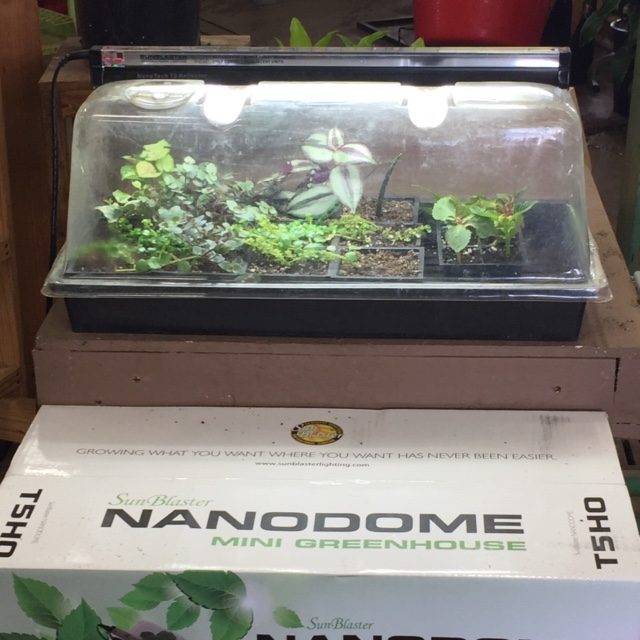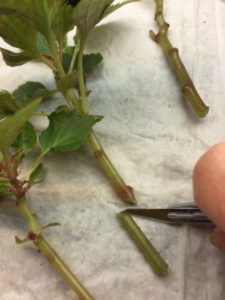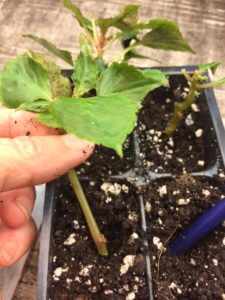
-Pam Scott-
It’s hard to believe that we are working our way swiftly through fall, yet the nights are getting cooler, the days are noticeably shorter, and the sun is much lower in the southern sky than it was a few weeks ago. After a rocking growing season this year, we are beginning to close down the flower garden for the season, bringing some plants indoors to winter over and letting the rest of the garden go to seed for food and shelter for birds and insects.
This is the beginning of a quiet 8 weeks where gardeners can take their boots off, put their feet on the couch, read gardening books and dream of spring. However, it’s hard to quell the ever-present need to see things grow, the urge to nurture. This is a good time to think about rooting some ornamental plant cuttings for next spring’s planting, instead of letting your warm weather annuals die off in the first fall frost. Annual plants such as impatiens, lantana, ageratum, verbena, scented geranium, zonal geraniums, petunias, herbs, as well as some tropical house plants can be easily propagated to make more plants. I think more plants are always a good thing.
Cuttings from most woody plants such as clematis, dogwood, elderberry, forsythia, hydrangea, boxwood and viburnum should be taken from softwood, semi-ripe or hardwood cuttings in the spring and summer. Stem cuttings from fast growing annuals can be taken from plants any time before the frost gets them or from plants brought inside for the winter.
There are a few things you will need to get started before taking your cuttings;
- Clippers– It’s good to keep them sterilized between cuttings with a dip in alcohol
- Sterile scalpel or sharp knife
- Damp towels to wrap your cuttings in to keep them hydrated
- Small pots with drainage filled loosely with a moistened sterile potting mix- A half perlite/half peat moss mix will work or, a good seed starting mix such as Black Gold or Light Warrior will work.
- Rooting hormone – for woody stemmed plants
- A Pencil or chop stick to use as a dibble to make a planting hole in the soil
- Bright indirect light source
- Zip lock bags, a clear lidded plastic storage container or a Nanodome to keep your plants in a high humidity environment.
So… this is a good time to chat about my favorite garden toy, the Nanodome. The Nanodome
is a small 10”x20” indoor greenhouse that can be used for indoor seed starting as well as plant propagation. It fits nicely on top of a heat mat, which can be used for germinating heat-loving seeds such as tomatoes and peppers, as well as for propagation of heat-loving woody-stemmed plants. The Nanodome is the perfect size to use for maintaining high humidity for your rooting cuttings and has a T5 fluorescent bulb to act as a light source when they start to grow. If you have more than one Nanodome they will plug end-to-end so they can be put on the same electric cord and light timer. I use my Nanodomes year round for seed starting and plant propagation. An added bonus of the Nanodome is that it makes a great holiday gift for kids – it’s their own cute little green house.

Now that you have your plant propagation station set up you will want to choose healthy vigorous plants to work with. Take your cuttings in the morning when they are still well-hydrated. Choose stems about 3-6 inches long, cut them halfway between leaf nodes. Always take more cuttings than you think you will need, as not all of the cuttings will end up rooting successfully. Wrap your stems in moist towels to keep them hydrated until you are ready to plant. When you have collected all the cuttings that you want to root, you are ready to plant.
Dibble a 1”-3” hole in your soil-filled pots. For most plants you will want to bury one leaf node per cutting. If using large pots with several cuttings in each pot, estimate one square inch per cutting. Remove all of the foliage from your cutting except for the top few leaves, remove all flowers and buds as they will drain energy away from root formation. Recut the stem, at an angle to just below the bottom leaf node, this node is where most root formation will occur, some plants will root all the way up the stem. You will want to use a sharp knife or scalpel for this so as not to crush the fragile cells of the stem.You can dip one inch of the stem into a rooting hormone (this is advised for woody stems but is optional for most soft and semi-soft-stem annuals). Insert the stem into the hole in the soil and gently fill in the hole, pressing lightly.

Cover your cutting and pot with a humidity dome or a Zip lock bag making sure that the plant does not touch the sides of the dome or bag, which may cause your plant to rot. Put your rooting pot into a bright area with no direct sunlight, making sure the soil stays evenly moist, but never soggy. Most rooting plants will enjoy temperatures between 65-75 degrees. Your cuttings will start to show signs of root growth in 4-6 weeks. Check for leaf growth and gently pull on the stem to see if roots have taken hold in the soil. When the roots are about an inch long you can start opening the bag or humidome for a few hours a day to acclimate the plants to lower humidity.
When your plants have become acclimated, start to slowly introduce them to more intense amounts of daylight over the course of a few days, being careful not to burn or dehydrate the new growth. At this point you can up pot them into a denser, nutrient free soil mix such as Mcenroe planting mix. You can start to fertilize your new plants with a slow release low nitrogen fertilizer such as Biothrive when they have become well established and are showing signs of active leaf growth.
Experiment with propagating different annuals, shrubs, herbs and house plants throughout the year. You will be amazed by how quickly you can fill up your garden with beautiful plants and have enough left over to share with friends.
You can find propagation supplies, potting medium, clippers, scalpels, Nanadomes and plenty of plants at Fifth Season Gardening.

Leave a Reply